warning DODGE SPRINTER 2007 2.G Owners Manual
[x] Cancel search | Manufacturer: DODGE, Model Year: 2007, Model line: SPRINTER, Model: DODGE SPRINTER 2007 2.GPages: 393, PDF Size: 7.61 MB
Page 179 of 393
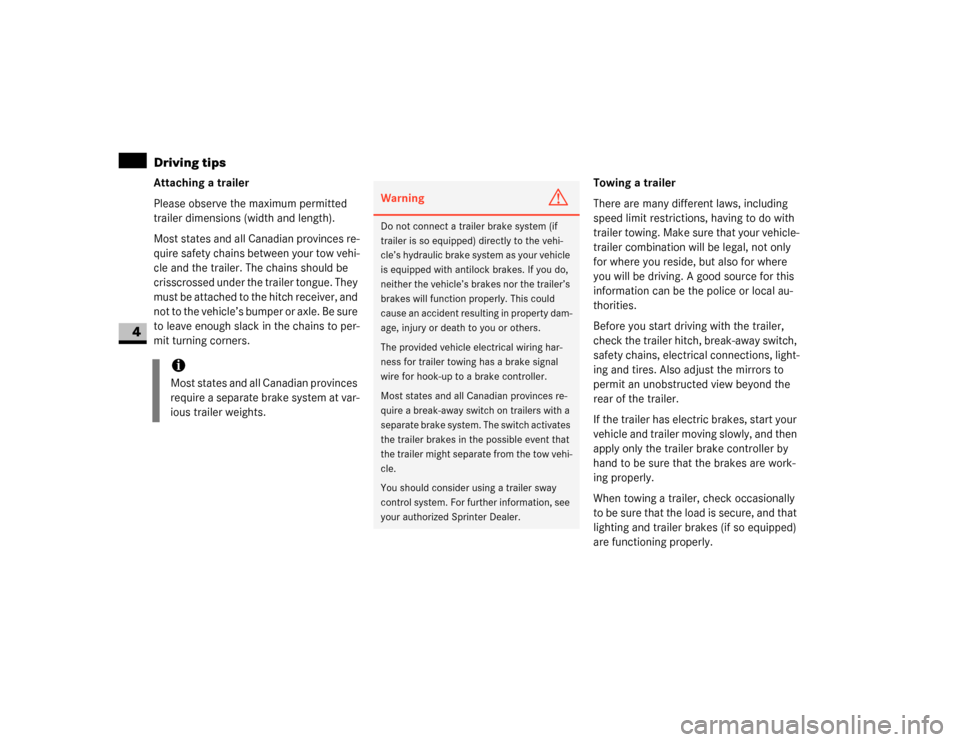
178 OperationDriving tips
4
Attaching a trailer
Please observe the maximum permitted
trailer dimensions (width and length).
Most states and all Canadian provinces re-
quire safety chains between your tow vehi-
cle and the trailer. The chains should be
crisscrossed under the trailer tongue. They
must be attached to the hitch receiver, and
not to the vehicle’s bumper or axle. Be sure
to leave enough slack in the chains to per-
mit turning corners.Towing a trailer
There are many different laws, including
speed limit restrictions, having to do with
trailer towing. Make sure that your vehicle-
trailer combination will be legal, not only
for where you reside, but also for where
you will be driving. A good source for this
information can be the police or local au-
thorities.
Before you start driving with the trailer,
check the trailer hitch, break-away switch,
safety chains, electrical connections, light-
ing and tires. Also adjust the mirrors to
permit an unobstructed view beyond the
rear of the trailer.
If the trailer has electric brakes, start your
vehicle and trailer moving slowly, and then
apply only the trailer brake controller by
hand to be sure that the brakes are work-
ing properly.
When towing a trailer, check occasionally
to be sure that the load is secure, and that
lighting and trailer brakes (if so equipped)
are functioning properly.
iMost states and all Canadian provinces
require a separate brake system at var-
ious trailer weights.
Warning
G
Do not connect a trailer brake system (if
trailer is so equipped) directly to the vehi-
cle’s hydraulic brake system as your vehicle
is equipped with antilock brakes. If you do,
neither the vehicle’s brakes nor the trailer’s
brakes will function properly. This could
cause an accident resulting in property dam-
age, injury or death to you or others.
The provided vehicle electrical wiring har-
ness for trailer towing has a brake signal
wire for hook-up to a brake controller.
Most states and all Canadian provinces re-
quire a break-away switch on trailers with a
separate brake system. The switch activates
the trailer brakes in the possible event that
the trailer might separate from the tow vehi-
cle.
You should consider using a trailer sway
control system. For further information, see
your authorized Sprinter Dealer.
Page 180 of 393

179 Operation
Driving tips
4
Always secure items in the trailer to pre-
vent load shifts while driving.
Take into consideration that when towing a
trailer, the handling characteristics are dif-
ferent and less stable from those when op-
erating the vehicle without a trailer. It is
important to avoid sudden maneuvers.
The vehicle and trailer combination is
heavier, and therefore is limited in acceler-
ation and climbing ability, and requires
longer stopping distances. It is more prone
to reacting to side wind gusts, and requires
more sensitive steering input.
In order to gain skill and an understanding
of the vehicle’s behavior, you should prac-
tice turning , st opping and backing up in a n
area which is free from traffic.
If possible, do not brake abruptly, but rath-
er engage the brake slightly at first to per-
mit the trailer to activate its brake. Then
increase the braking force.
Warning
G
Take into consideration that when towing a
trailer, the handling characteristics are dif-
ferent and less stable from those when op-
erating the vehicle without a trailer.
It is important to avoid sudden maneuvers.
Sudden maneuvers may lead to loss of con-
trol over the vehicle-trailer combination.
This could cause an accident resulting in
property damage or injury to you or others.!
CAUTION
If the transmission hunts between
gears on inclines, manually shift to a
lower gear (select
"4", "3", "2" or
"1").
A lower gear and reduction of speed re-
duces the chance of the engine over-
loading and / or overheating.
When going down a long hill, shift into
a lower gear and use the engine’s brak-
ing effect. Avoid riding the brakes, thus
overheating the vehicle and trailer
brakes.
If the engine coolant rises to an ex-
tremely high temperature (coolant tem-
perature needle approaching the red
zone) when the air conditioner is on,
turn off the air conditioner. Engine
coolant heat can be additionally vented
by opening the windows, switching the
climate control fan speed to high and
setting the temperature control to the
maximum hot position.
Extreme care must be exercised since
your vehicle with a trailer will require
additional passing distance ahead than
when driving without a trailer. Because
your vehicle and trailer is longer than
your vehicle alone, you will also need to
go much farther ahead of the passed
vehicle before you can return to your
lane.
Page 181 of 393
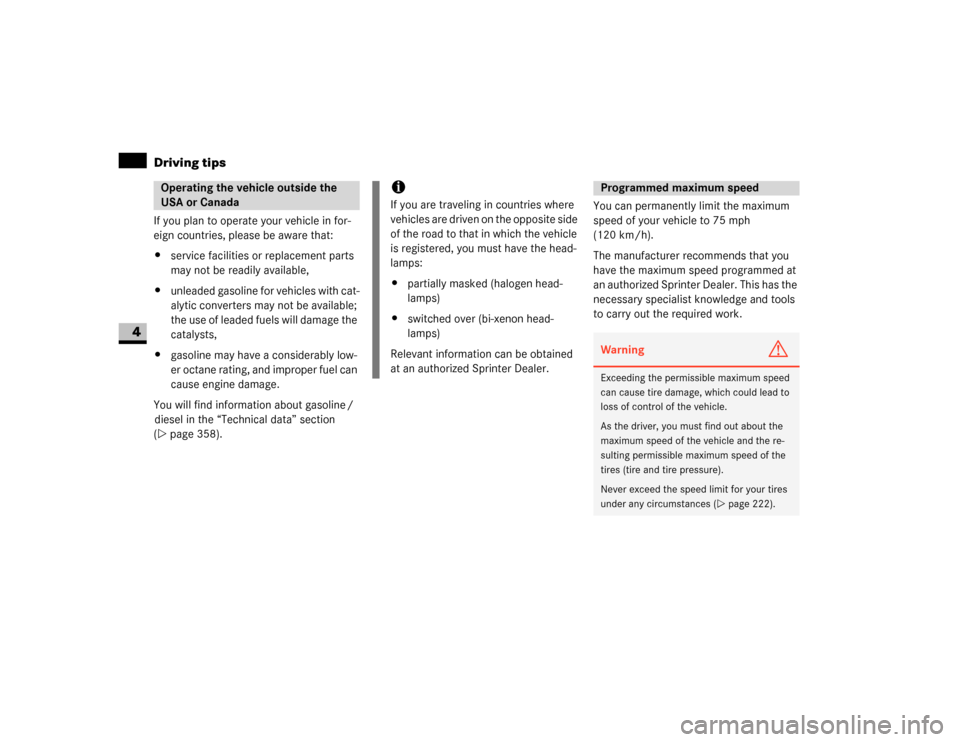
180 OperationDriving tips
4
If you plan to operate your vehicle in for-
eign countries, please be aware that:
\4service facilities or replacement parts
may not be readily available,
\4unleaded gasoline for vehicles with cat-
alytic converters may not be available;
the use of leaded fuels will damage the
catalysts,
\4gasoline may have a considerably low-
er octane rating, and improper fuel can
cause engine damage.
You will find information about gasoline /
diesel in the “Technical data” section
(\2page 358).You can permanently limit the maximum
speed of your vehicle to 75 mph
(120 km/h).
The manufacturer recommends that you
have the maximum speed programmed at
an authorized Sprinter Dealer. This has the
necessary specialist knowledge and tools
to carry out the required work.Operating the vehicle outside the
USA or Canada
iIf you are traveling in countries where
vehicles are driven on the opposite side
of the road to that in which the vehicle
is registered, you must have the head-
lamps:
\4partially masked (halogen head-
lamps)
\4switched over (bi-xenon head-
lamps)
Relevant information can be obtained
at an authorized Sprinter Dealer.
Programmed maximum speed Warning
G
Exceeding the permissible maximum speed
can cause tire damage, which could lead to
loss of control of the vehicle.
As the driver, you must find out about the
maximum speed of the vehicle and the re-
sulting permissible maximum speed of the
tires (tire and tire pressure).
Never exceed the speed limit for your tires
under any circumstances (\2page 222).
Page 182 of 393

181 Operation
Driving tips
4
Check regularly, e.g. weekly or when refu-
eling:
\4the vehicle lighting
\4the condition of the tires (\2page 201)
and the tire pressures (\2page 210)
\4the engine oil level (\2page 187)
\4the brake fluid level (\2page 192)
\4the fluid level in the windshield washer
system / headlamp cleaning system
reservoir (\2page 193)
\4the contamination level of the rear air-
conditioning air cleaner (\2page 240)
Your vehicle is equipped with monolithic-
type catalytic converters, an important el-
ement in conjunction with the oxygen sen-
sors to achieve substantial control of the
pollutants in the exhaust emissions. Keep
your vehicle in proper operating condition
by following our recommended mainte-
nance instructions as outlined in your Ser-
vice Booklet.Your vehicle is equipped with an oxidation
catalyst, an important element in conjunc-
tion with the oxygen sensors to achieve
substantial control of the pollutants in the
exhaust emissions. Keep your vehicle in
proper operating condition by following
our recommended maintenance instruc-
tions as outlined in your Service Booklet.Regular checksCatalytic converter (gasoline engine)
!
CAUTION
To prevent damage to the catalytic con-
verters, only use premium unleaded
gasoline in this vehicle.
Any noticeable irregularities in engine
operation should be repaired promptly.
Otherwise, excessive unburned fuel
may reach the catalytic converter,
causing it to overheat and potentially
start a fire.
Warning
G
As with any vehicle, do not idle, park or op-
erate this vehicle in areas where combusti-
ble materials such as grass, hay, or leaves
can come into contact with the hot exhaust
system, as these materials could be ignited
and cause a vehicle fire.
Oxidation catalyst (diesel engine)Warning
G
As with any vehicle, do not idle, park or op-
erate this vehicle in areas where combusti-
ble materials such as grass, hay, or leaves
can come into contact with the hot exhaust
system, as these materials could be ignited
and cause a vehicle fire.
Page 183 of 393
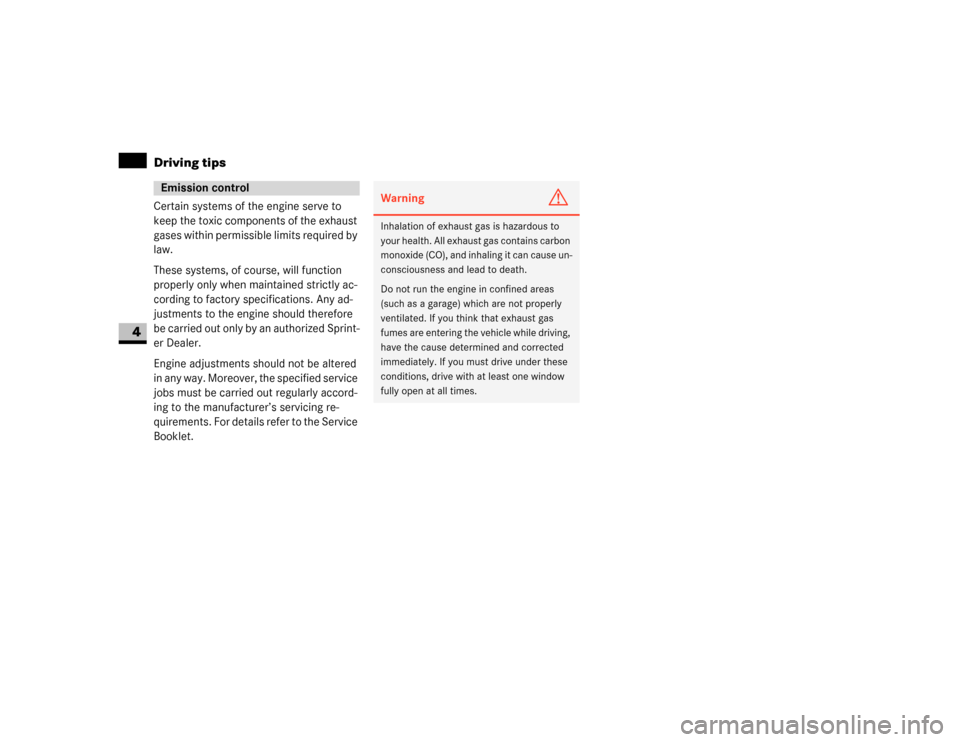
182 OperationDriving tips
4
Certain systems of the engine serve to
keep the toxic components of the exhaust
gases within permissible limits required by
law.
These systems, of course, will function
properly only when maintained strictly ac-
cording to factory specifications. Any ad-
justments to the engine should therefore
be carried out only by an authorized Sprint-
er Dealer.
Engine adjustments should not be altered
in any way. Moreover, the specified service
jobs must be carried out regularly accord-
ing to the manufacturer’s servicing re-
quirements. For details refer to the Service
Booklet.Emission control
Warning
G
Inhalation of exhaust gas is hazardous to
your health. All exhaust gas contains carbon
monoxide (CO), and inhaling it can cause un-
consciousness and lead to death.
Do not run the engine in confined areas
(such as a garage) which are not properly
ventilated. If you think that exhaust gas
fumes are entering the vehicle while driving,
have the cause determined and corrected
immediately. If you must drive under these
conditions, drive with at least one window
fully open at all times.
Page 184 of 393
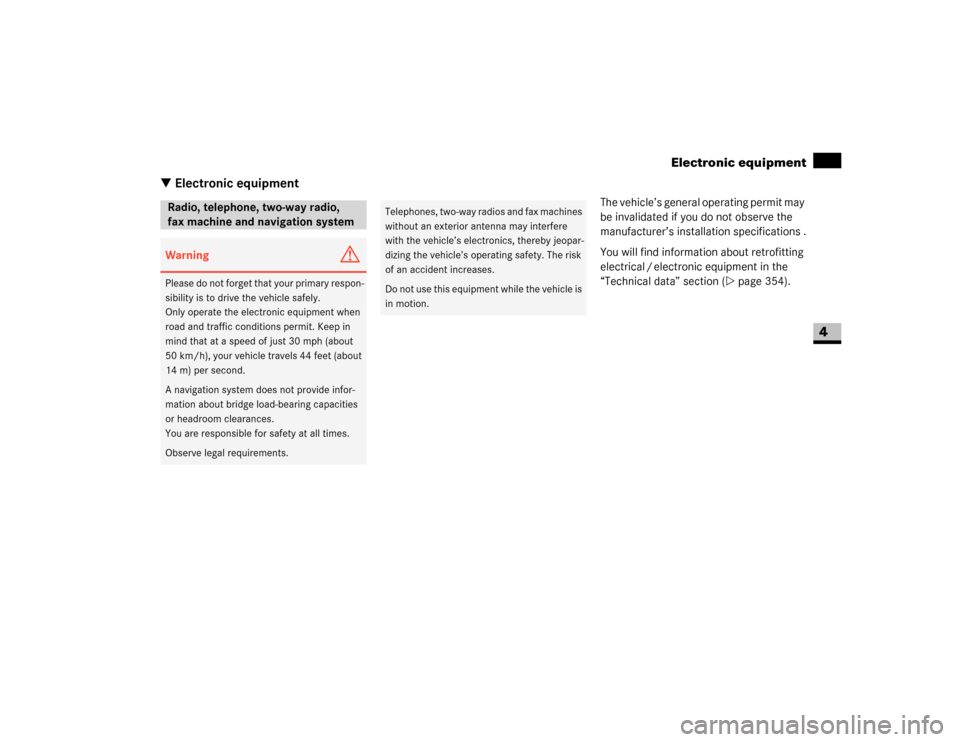
183 Operation
Electronic equipment
4
\3 Electronic equipment
The vehicle’s general operating permit may
be invalidated if you do not observe the
manufacturer’s installation specifications .
You will find information about retrofitting
electrical / electronic equipment in the
“Technical data” section (\2page 354).
Radio, telephone, two-way radio,
fax machine and navigation systemWarning
G
Please do not forget that your primary respon-
sibility is to drive the vehicle safely.
Only operate the electronic equipment when
road and traffic conditions permit. Keep in
mind that at a speed of just 30 mph (about
50 km/h), your vehicle travels 44 feet (about
14 m) per second.
A navigation system does not provide infor-
mation about bridge load-bearing capacities
or headroom clearances.
You are responsible for safety at all times.
Observe legal requirements.
Telephones, two-way radios and fax machines
without an exterior antenna may interfere
with the vehicle’s electronics, thereby jeopar-
dizing the vehicle’s operating safety. The risk
of an accident increases.
Do not use this equipment while the vehicle is
in motion.
Page 185 of 393
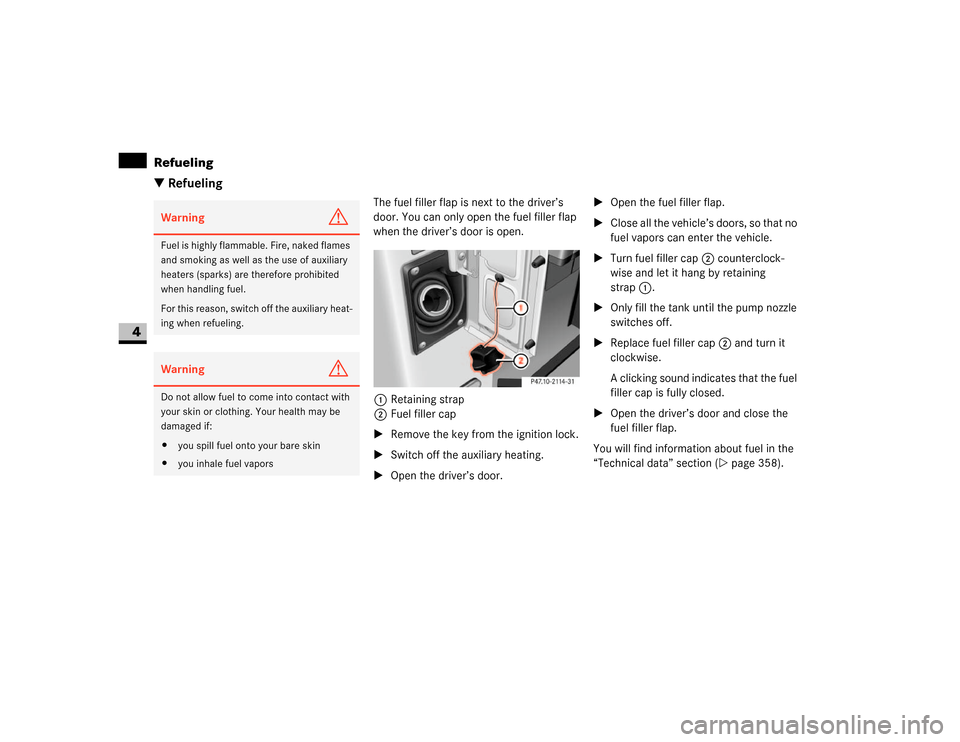
184 OperationRefueling
4
\3 Refueling
The fuel filler flap is next to the driver’s
door. You can only open the fuel filler flap
when the driver’s door is open.
1Retaining strap
2Fuel filler cap
\1Remove the key from the ignition lock.
\1Switch off the auxiliary heating.
\1Open the driver’s door.\1Open the fuel filler flap.
\1Close all the vehicle’s doors, so that no
fuel vapors can enter the vehicle.
\1Turn fuel filler cap2 counterclock-
wise and let it hang by retaining
strap1.
\1Only fill the tank until the pump nozzle
switches off.
\1Replace fuel filler cap2 and turn it
clockwise.
A clicking sound indicates that the fuel
filler cap is fully closed.
\1Open the driver’s door and close the
fuel filler flap.
You will find information about fuel in the
“Technical data” section (\2page 358).
Warning
G
Fuel is highly flammable. Fire, naked flames
and smoking as well as the use of auxiliary
heaters (sparks) are therefore prohibited
when handling fuel.
For this reason, switch off the auxiliary heat-
ing when refueling.Warning
G
Do not allow fuel to come into contact with
your skin or clothing. Your health may be
damaged if:
\4you spill fuel onto your bare skin
\4you inhale fuel vapors
Page 186 of 393

185 Operation
Engine
4
\3 EngineOpening 1Release lever
\1Pull release lever1 under the instru-
ment panel on the left-hand side in the
driver’s footwell.
The hood is released.2Securing hook
\1Push up securing hook lever 2.
3Support strutHoodWarning
G
Do not pull the release lever while the vehi-
cle is in motion. The hood could otherwise
open, thereby impairing visibility and leading
to loss of control of the vehicle.
For this reason, only open the hood when
the vehicle is parked.!
CAUTION
Make sure that the windshield wipers
are not folded away from the wind-
shield. The windshield wipers or the
hood may otherwise be damaged.
N88.40-2060-31
N88.40-2063-31N88.40-2062-31
Page 187 of 393
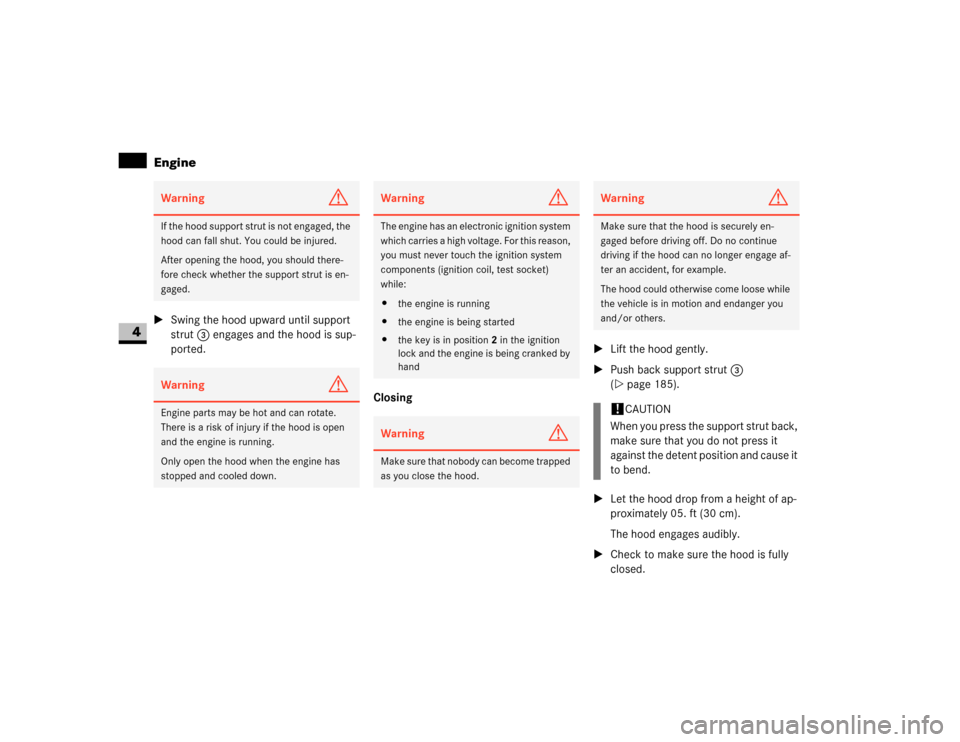
186 OperationEngine
4
\1Swing the hood upward until support
strut3 engages and the hood is sup-
ported.
Closing\1Lift the hood gently.
\1Push back support strut3
(\2page 185).
\1Let the hood drop from a height of ap-
proximately 05. ft (30 cm).
The hood engages audibly.
\1Check to make sure the hood is fully
closed.Warning
G
If the hood support strut is not engaged, the
hood can fall shut. You could be injured.
After opening the hood, you should there-
fore check whether the support strut is en-
gaged.Warning
G
Engine parts may be hot and can rotate.
There is a risk of injury if the hood is open
and the engine is running.
Only open the hood when the engine has
stopped and cooled down.
Warning
G
The engine has an electronic ignition system
which carries a high voltage. For this reason,
you must never touch the ignition system
components (ignition coil, test socket)
while:
\4the engine is running
\4the engine is being started
\4the key is in position2 in the ignition
lock and the engine is being cranked by
handWarning
G
Make sure that nobody can become trapped
as you close the hood.
Warning
G
Make sure that the hood is securely en-
gaged before driving off. Do no continue
driving if the hood can no longer engage af-
ter an accident, for example.
The hood could otherwise come loose while
the vehicle is in motion and endanger you
and/or others.!
CAUTION
When you press the support strut back,
make sure that you do not press it
against the detent position and cause it
to bend.
Page 188 of 393

187 Operation
Engine
4
If the hood can be raised slightly, it
is not properly engaged.
\1Open it again and allow it to drop from
a slightly greater height.
Mechanical elements and the lubricants
used for them must be carefully matched.
For this reason, only brands tested and ap-
proved by the manufacturer should be
used. Please contact your Sprinter Dealer
to obtain the necessary information. No lu-
bricant additives should be used.
The use of such additives could affect your
warranty rights. Information is available
from any authorized Sprinter Dealer.
For specifications of engine oils, coolant
and brake fluid, see "Service products and
capacities" (\2page 355) and contact your
authorized Sprinter Dealer.The vehicle consumes a maximum of
1 US qt (1.0 l) oil per 620 miles (1000 km),
depending on your driving style.
Engine oil consumption may even be high-
er if:
\4the vehicle is new
\4you mainly operate the vehicle under
arduous operating conditions
\4you often drive at high engine speeds
The engine oil consumption can only be
judged after a lengthy distance has been
covered.Check the engine oil level on a regular ba-
sis, for example weekly or each time you
refuel.!
CAUTION
Do not use your hands to push the
hood down. Doing so could damage it.
Service products
Warning
G
If handled incorrectly, service products can
constitute a health risk f o r p e o p l e a n d a n e n -
vironmental hazard.
Always observe relevant guidelines for han-
dling, storing and disposing of service prod-
ucts.Engine oil
iIf the oil level exceeds the maximum
level several times during operation,
have the malfunction rectified immedi-
ately at an authorized Sprinter Dealer.